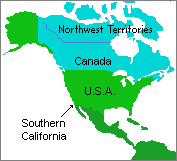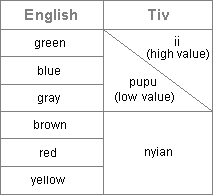Language is more than just a means of communication. It influences our culture and even our thought processes. During the first four decades of the 20th century, language was viewed by American linguists and anthropologists as being more important than it actually is in shaping our perception of reality. This was mostly due to Edward Sapir and his student Benjamin Whorf who said that language predetermines what we see in the world around us. In other words, language acts like a polarizing lens on a camera in filtering reality--we see the real world only in the categories of our language.
![]()
 |
Cross cultural comparisons of such things as color terms were used by Sapir and Whorf as evidence of this hypothesis. When we perceive color with our eyes, we are sensing that portion of electromagnetic radiation that is visible light. In fact, the spectrum of visible light is a continuum of light waves with frequencies that increase at a continuous rate from one end to the other. In other words, there are no distinct colors like red and green in nature. Our culture, through language, guides us in seeing the spectrum in terms of the arbitrarily established categories that we call colors. Different cultures may divide up the spectrum in different ways. This can be seen in the comparison of some English language colors with their counterparts in the Tiv language of Nigeria:
|
Note: value refers to the lightness or darkness of a color. High value is light and low value is dark. |
Sapir and
Whorf interpreted these data as indicating that colors are not objective, naturally
determined segments of reality. In other words, the colors we see
are predetermined
by what our culture prepares us to see. This example
used to support the Sapir-Whorf hypothesis
![]() was
objectively tested in the 1960's. That research indicated that they went too
far. All normal humans share similar sense perceptions of color despite differences
in color terminology from one language to another. The physiology of our eyes is
essentially the same. People all over the world can see subtle gradations of color
and can comprehend other ways of dividing up the spectrum of visible light. However,
as a society's economy and technology increase in complexity, the number of color terms
usually also increases. That is to say, the spectrum of visible light gets
subdivided into more categories. As the environment changes, culture and language
typically respond by creating new terminology to describe it.
was
objectively tested in the 1960's. That research indicated that they went too
far. All normal humans share similar sense perceptions of color despite differences
in color terminology from one language to another. The physiology of our eyes is
essentially the same. People all over the world can see subtle gradations of color
and can comprehend other ways of dividing up the spectrum of visible light. However,
as a society's economy and technology increase in complexity, the number of color terms
usually also increases. That is to say, the spectrum of visible light gets
subdivided into more categories. As the environment changes, culture and language
typically respond by creating new terminology to describe it.
NOTE: In 1976 Paul Kay, a University of California, Berkeley linguistics professor, led a team of researchers in collecting color terms used by 110 different languages around the world. Reexamining these data in 2006, Delwin Lindsey and Angela Brown of Ohio State University, Columbus discovered that most languages in this study do not make a distinction between green and blue. Further, the closer the homeland of a language group is to the equator the less likely they are to distinguish between green and blue. Lindsey suggests as a possible explanation that people in intensely sunny environments, such as open country near the equator, have had their ability to see color altered due to the yellowing of the eye lens caused by excessive ultraviolet radiation.

|
It is now clear that the terminology used by a culture primarily reflects that culture's interests and concerns. For instance, Indians in Canada's Northwest Territories typically have at least 13 terms for different types and conditions of snow, while most non-skiing native Southern Californians use only 2 terms--ice and snow. That does not mean that the English language only has 2 terms. Quite the contrary, there are many more English words that refer to different states of frozen water, such as blizzard, dusting, flurry, frost, hail, hardpack, powder, sleet, slush, and snowflake. The point is that these terms are rarely if ever used by people living in tropical or subtropical regions because they rarely encounter frozen water in any form other than ice cubes. The distinctions between different snow conditions are not relevant to everyday life and children may not even have the words explained to them. However, people in these warmer regions make fine distinctions about other phenomena that are important to them. For instance, coastal Southern Californians often have dozens of surfing related words that would likely be unknown to most Indians in the Northwest Territories or to people living in Britain for that matter.
The number of terms related to a particular topic also may be greater or smaller depending on such social factors as gender. For example, North American women generally make far more color distinctions than do men. This may be largely due to the fact that subtle color differences are important factors in women's clothing and makeup. Parents and peers usually encourage and train girls early to be knowledgeable about these distinctions.
|
|
 |

|
|
The cultural environment that people grow up in can have surprising effects on how they interpret the world around them. This became apparent during a Washington D.C. murder trial in 2002. A deaf man was convicted of stabbing to death two of his classmates at Gallaudet University. At his trial, the defendant said that he was told to do it by mysterious black-gloved hands. His delusions did not come in the form of spoken language. He was told to commit these brutal murders through sign language--his mode of communication. Another example is provided by Guugu Timithirr language speakers of the Cape York Peninsula in northeastern Australia. This group of Aborigines do not have words for left, right, front, or back. They use absolute rather than relative directions. When they refer to people or objects in their environment, they use compass directions. They would say "I am standing southwest of my sister" rather than "I am standing to the left of my sister." Critics of the Sapir-Whorf hypothesis would point out that the Aborigines who speak this language also usually learn English and can use left, right, front, and back just as we do. However, if they do not learn English during early childhood, they have difficulty in orienting themselves relatively and absolute orientation makes much more sense to them.
